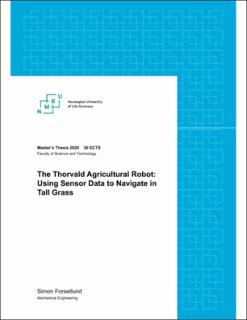| dc.contributor.advisor | Grimstad, Lars | |
| dc.contributor.advisor | Mayoral Banos, José Carlos | |
| dc.contributor.author | Forsetlund, Simon Benjamin Linder | |
| dc.coverage.spatial | Norway, Akershus, Ås | en_US |
| dc.date.accessioned | 2021-01-02T20:29:24Z | |
| dc.date.available | 2021-01-02T20:29:24Z | |
| dc.date.issued | 2020 | |
| dc.identifier.uri | https://hdl.handle.net/11250/2721192 | |
| dc.description.abstract | This master’s thesis presents algorithms and new methods for autonomous navigation of a grass cutting robot. For the purpose of the current research, the selected platform was the Thorvald II mobile grass cutting robot. Thorvald II is an agricultural robot capable of working in many different environments such as greenhouses and open fields. As the modular robotic system is developed to be flexible, the robot can perform many different operations and may be configured in different shapes and forms. However, this thesis studies the specific grass cutting robot configuration.
For outdoor applications, the use of Global Navigation Satellite System (GNSS) based navigation has become a trend due to its ability to deliver high precision positioning. However, many fields lie in undulating terrain. This makes GNSS based navigation unreliable and error prone, resulting in ineffective and wasteful cutting of grass. Optimizing the robot’s ability to efficiently navigate and correct its course in real time, saves the farmer money and time which ultimately promotes the use of the Thorvald robotic system.
In this thesis, a method is developed to allow the robot to identify the edge separating the cut and uncut grass. By detecting this line, the robot and its cutting tool can autonomously manoeuvre to precisely follow the line as the robot makes its way through the field. By applying a Multiple-criteria decision-making (MCDM) technique, the use of a Light Identification Detection and Ranging (LIDAR) sensor is suggested to generate the necessary point cloud data. Algorithms are developed to manipulate the point cloud and estimate the line, using the Random Sample Consensus (RANSAC) robust estimation model. The Robotic Operating System (ROS) framework and its key features are discussed, and finally used to implement the developed algorithms. A motion model is defined, and velocity control is implemented using a proportionate (P) controller, and a proportionate-derivate (PD) controller.
Testing on captured field data and simulations show that the robot is successfully able to detect the line in the grass. The algorithm’s robustness is tested and performs well, even in environments with significant noise and obstacles present. Testing of the implemented velocity control have produced promising results, as the robot is able to navigate along the line autonomously. | en_US |
| dc.description.abstract | I denne masteroppgaven presenteres algoritmer og nye metoder for autonom navigasjon av en grasklippende robot. Den mobile grasklipper-roboten Thorvald II ble valgt som plattform for denne oppgavens formål. Thorvald II er en jordbruksrobot som kan arbeide i mange forskjellige miljøer, som drivhus og åpne jorder. Ettersom det modulære robot-systemet er utviklet for å være fleksibelt, kan roboten utføre mange forskjellige operasjoner og kan konfigureres i forskjellige former og modeller. I denne oppgaven blir imidlertid den grasklippende robotkonfigurasjonen studert. | en_US |
| dc.language.iso | eng | en_US |
| dc.publisher | Norwegian University of Life Sciences, Ås | en_US |
| dc.rights | Attribution-NonCommercial-NoDerivatives 4.0 Internasjonal | * |
| dc.rights.uri | http://creativecommons.org/licenses/by-nc-nd/4.0/deed.no | * |
| dc.subject | Pointcloud | en_US |
| dc.subject | Thorvald | en_US |
| dc.subject | GrassRobotics | en_US |
| dc.title | The Thorvald agricultural robot : using sensor data to navigate in tall grass | en_US |
| dc.title.alternative | Landbruksroboten Thorvald : bruk av sensordata for navigasjon i høyt gress | en_US |
| dc.type | Master thesis | en_US |
| dc.source.pagenumber | 148 | en_US |
| dc.description.localcode | M-MPP | en_US |

